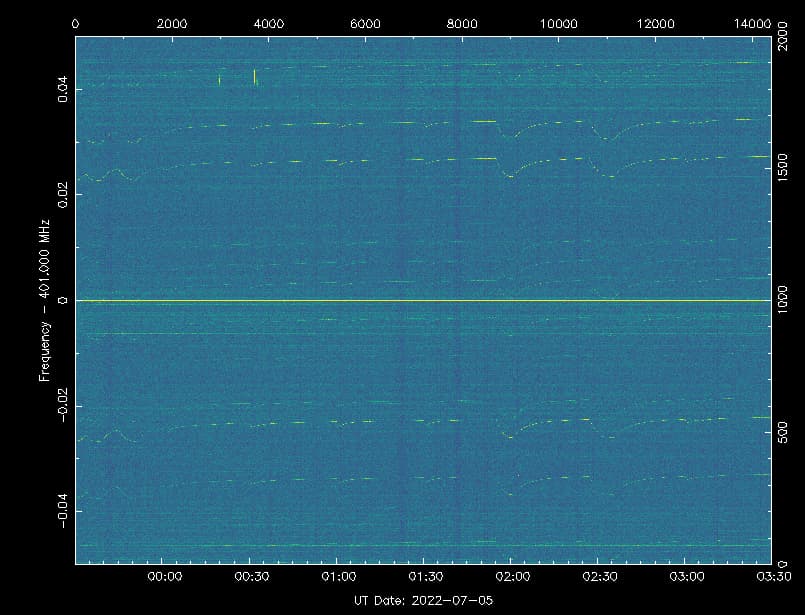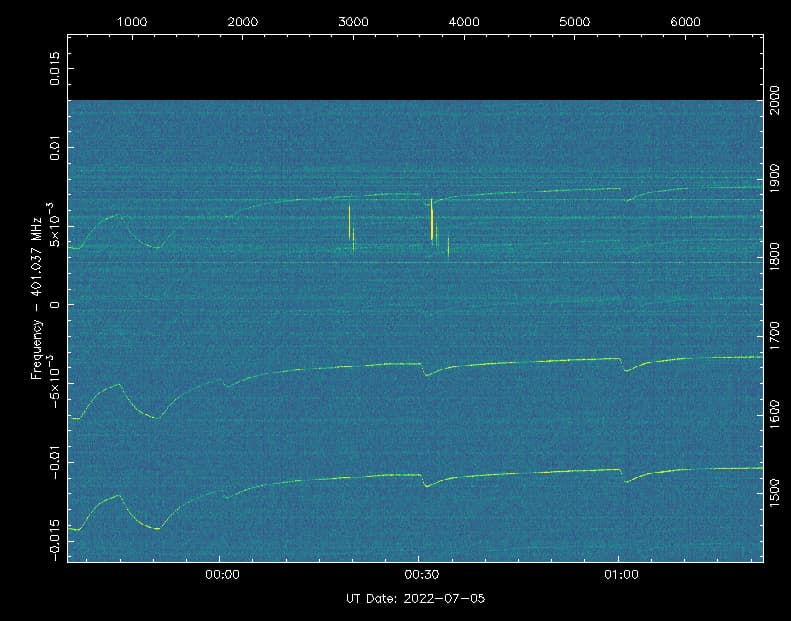Suggestion is now approved, and I’ve scheduled a couple observations for the next days.
Platform-1’s baud rate has been decreased to 4k8. See the note here: Add Platform-1 to SatNOGS DB (#234) · Issues · librespacefoundation / SatNOGS Operations · GitLab, it has already been registered to the network by fredy (see: SatNOGS DB - Platform-1).
We would appreciate some new observations for the change, in case anybody is interested on listening ![]()
Does someone know what happened to Foresail-1? I’ve not seen any data recently…
Hi All,
I am a SPIN engineer, we are still trying to find SPiN-1.
Our current strategy is to track our satellite with the Norad ID 52738 (Planetum1 TLE) as they were released together.
Can more tracking from Satnogs be added?
We are still trying to also enable the beacon manually over UK and NZ, so tracking close by there will help.
Thank you!
I’m not sure if this is a good strategy, given that the objects near Planetum are identified in spacetrack. However sometimes these identifications are wrong.
The nearest unknown object near Planetum is OBJECT M, the one we follow and it is already far away from Planetum to be on the same observation. What I suggest is to get historical TLE data from spacetrack and try to find out which objects where close to Planetum at the first versions of the TLE, then check if they are identified now and target the unknown ones, if all are identified then check object by object.
@arthurspin Let me know for your decision on the object you believe we should track and I’ll change it in DB and Network.
I will run a 4h STRF between 05-07-2022 23:30 UTC and 06-07-2022 03:30 UTC. lets see if we can find some signals.
I’ve created a new satellite for tracking these signals:
https://db.satnogs.org/satellite/QBTU-7656-9422-5105-6532
Good day,
We have an unknown satellite on 401.050 following 52766 some first attempts to decode the signal seem to point to BPSK.
gr_satellites CHECK-1k2-BPSK.yml --rawint16 unknown_iq_6186645.wav --iq --samp_rate 48e3
***** VERBOSE PDU DEBUG PRINT ******
((transmitter . 1k2 BPSK LilacSat-1 downlink))
pdu length = 81 bytes
pdu vector contents =
0000: 9f fe fb ff ff fd fb ff ff fe ff ff ff ff fe ff
0010: d7 fb ff 69 7f bf ed d6 fe 79 f6 cf 5d be fc c8
0020: d7 bd bb f7 cb 11 bb 9f ed 75 bf af 3f fd 5f ff
0030: ef 5e df cd 76 ed f3 e9 bd a5 3b d7 7e ee dc db
0040: 17 b3 53 b0 58 52 69 82 99 dd de bf ba b0 74 62
0050: c7
************************************
***** VERBOSE PDU DEBUG PRINT ******
((transmitter . 1k2 BPSK LilacSat-1 downlink))
pdu length = 81 bytes
pdu vector contents =
0000: ff ff ff ff ff ff ff ff ff ff ff ff ff ff ff ff
0010: ff ff ff ff ff ff ff ff df ff ff ff ff ff ff ff
0020: ff ff ff ff ff ff fd ff ff ff ff ff ff df ff ff
0030: ee a1 df fa f7 7f 47 ff ef ef 0a 3e 93 9e 48 59
0040: 02 d3 34 2d d2 8a 53 13 16 76 b9 5a 07 8f 39 04
0050: 09
************************************
***** VERBOSE PDU DEBUG PRINT ******
((transmitter . 1k2 BPSK LilacSat-1 downlink))
pdu length = 81 bytes
pdu vector contents =
0000: ff ff ff ff ff ff ff ff ff ff ff ff ff ff ff ff
0010: fd ff ff ff ff ff ff ff ff ff ff ff 7f ff ff ff
0020: fb ff ff ff df be 7e ee ed cc bf bd 7f ff ad 4a
0030: a1 9d 36 bf c6 39 e5 d2 90 67 b8 93 6f f2 fc 81
0040: bb b4 a8 1e 8f ce 44 03 de d3 76 8e 68 35 48 e6
0050: c1
************************************
***** VERBOSE PDU DEBUG PRINT ******
((transmitter . 1k2 BPSK LilacSat-1 downlink))
pdu length = 81 bytes
pdu vector contents =
0000: ff ff ff ff ff ff ff ff ff ff ff ff ff ff ff ff
0010: ff ff ff ff ff ff ff ff ff ff ff ff ff ff ff ff
0020: ff ff ff ff ff ff ff ff ff ff ff ff ff ff ff ff
0030: ff ff ff ff ff ff ff ff ff ff ff ff ff ff ff ff
0040: ff be ff fb ff 7b fd bf ff ff df 8f 7f ff ed 7f
0050: 4d
************************************
***** VERBOSE PDU DEBUG PRINT ******
((transmitter . 1k2 BPSK LilacSat-1 downlink))
pdu length = 81 bytes
pdu vector contents =
0000: ff ff ff ff ff ff ff ff ff ff ff ff ff ff ff ff
0010: ff ff ff ff ff ff 7f ff ef ff ff ff fe ff ad fd
0020: dc 3f 7f b2 fb ef af 9c 4c fb fe 8f 7d f9 63 33
0030: 61 44 8f 63 7e 4b 35 99 ea 45 9f e7 3a 38 e7 92
0040: 13 4d 6b 6d 5c 4f 53 0d ac 0a eb d8 76 f4 34 21
0050: cf
************************************
Is there a change that this is SPIN-1 despite the BPSK and 50kHz high in frequency?
Hi Fredy,
Thank you for your answer
On our side, we will alternate between Planetum TLE and Object M TLE to maximize the chance of getting a signal from our satellite.
What do you think about the probability that our satellite is in the shadow of the planetum satellite?
Let’s keep the tracking on object M on your side, and we will come back to you if we have an update on our side.
Have a nice day
Arthur
Hi PE0SAT,
Thank you for your feedback,
Difficult to say right now, we need to analyze this data to be sure, but I don’t think that there is a high probability that these packets come from SPIN-01.
We will come back to you when we will have more information.
have a nice day
Arthur
Is the downlink frequency for SPIN-1 supposed to be exactly 401.000?
I saw on one document the lower limit = 401.000 & the upper limit = 402.000, suggesting that the downlink freq might be 401.500.
Thanks!
-Scott, K4KDR
Hi All,
My name is Saish, another engineer at Space Products and Innovation. We are currently tracking 52743 TLE. As mentioned before by one of my colleagues Ran, we are trying to enable beacon manually over UK and NZ.
Latest update from Satnogs that we noticed:
One of the tracking received good signal from SPiN-1 satellite (52743 TLE).
https://network.satnogs.org/observations/6177351/
But, I do not see any signal signatures in either waterfall or sound.
Can more tracking from Satnogs be added? It would be really helpful.
Thank you,
Regards,
Saish
The frequency is 401 MHz.
Our plan for the coming days is to track with the Norad ID 52743. We request additional additional tracking from Satnogs.
Hey @saish,
We still follow 52743 for SPiN. I’ve scheduled a couple of observations for the next 2 days, let us know if you want us to track more specific passes by giving us the start and end times (in UTC).
Thank you! As mentioned before, we are trying to also enable the beacon manually over UK and NZ, so tracking close by to there might help.
Thank you. After some research I believe this is URDANETA by satlantis, it has been reported on their website to be launch on 25th of May and that is active. most likely this is object AK (52765) that is flying very close to the tracked object of 52766 which is FORESAIL-1. URDANETA is also marked as having the same band frequency as SPiN-1 in the ITU database and has not been listed in Celestrack as identified.
Transferring from the #satnogs matrix channel:
There is a chance that SelfieSat is deployed, as there are some data from FossaSat-2E13. The TLE set we are going to use is the one in the previous link, propagated and changed to the temporary NORAD ID we use in DB:
SelfieSat
1 99392U 22199.14766297 .00000000 00000-0 00000-0 0 00
2 99392 97.5185 313.3268 0008366 81.2639 187.9514 15.12221563 00
I’ve scheduled a couple of observations for the next hours.
After some analysis on the tinygs observations of FossaSat-2E13 by @EelkeVisser, we found out that the satellite TLE that are in the site are not in accordance with the received data. For example when the data were received over Europe the satellite according to the TLE was over New Zealand.
We searched and found out that TLE of unidentified OBJECT AE (52760) is probably a good fit to follow for now. Also this object has a large radar cross section, so probably is the Vigoride deployer. Due to this big change on the TLE, I’ve removed all the future observations of SelfieSat and in the next minutes I’ll re-schedule most of them.

